Development of a BIM-Based Framework Using Reverberation Time (BFRT) as a Tool for Assessing and Improving Building Acoustic Environment
Abstract
:1. Introduction
2. Objectives and Research Methodology: Problem Identification and the Use of BIM as a Framework to Assess Acoustical Performance of Buildings
3. Parameters and Tools Used for the Development of the BIM-Based Framework
3.1. Using Visual Programming Language in BIM Methodology
3.2. Reverberation Time (RT) for the Assessment of Acoustic Room Behaviour
4. Proposed BIM Framework for Acoustic RT-Based Design in Indoor Areas (BFRT)
4.1. Stage 1—BIM Modelling
4.2. Stage 2—Data Extraction and RT Calculation
4.2.1. First Node Group—Stage 2: Room Level Selection
4.2.2. Second Node Group—Stage 2: Room Data Extraction
4.2.3. Third Node Group—Stage 2: RT Optimum Calculation
4.2.4. Fourth Node Group—Stage 2: RT Calculation and Visualization
4.3. Stage 3—Optimization Algorithm
- From the y limits of the acceptance interval, it is possible to calculate the minimum acoustic absorption surface () y and the maximum acoustic surface absorption () that the room under analysis should have. The bounding strategy is set from the Equations (4) and (5),where is the total absorption surface area corresponding to a wall coated with the material; is the total absorption surface area corresponding to a ceiling coated with the finishing material; and is the total absorption surface area corresponding to a floor with the finishing coating material, i.e.:
- 2.
- For each individual solution that meets the acceptance criterion, the objective functions are computed. These functions are two: the first one denoted as Ci is the cost of the investment (Equation (9)) and the second one is denoted as Di (Figure 9) which is the absolute value of the difference between the total absorption surface area that provides such a solution with respect to the optimal absorbent surface area () of the enclosure (Equation (10)).
- 3.
- Once obtained the set of solutions for the studied problem, the optimum solutions are calculated using of the Pareto front or frontier. The criterion of optimization has been the minimization of the cost and the difference between the absorbent surface area of the solution and the optimum absorbent surface area.The Pareto front is the set of possible solutions of optimization that are not dominated; a non-dominated solution being a solution that is not dominated by any other solution. The optimal Pareto solution will be that solution such that there is no other solution that will improve in a goal without becoming worse at least one of the other ones.
- 4.
- This algorithm ends by showing the solutions that belong to the Pareto fronts corresponding to each one of the 7 types of actions proposed in Table 3. Thus, the designer will be able to choose between the proposed solutions, as they all fulfil the criterion of a suitable RT.
5. Results: Case Study
5.1. Building for the Case Study
5.2. Data Extraction and RT Calculation (Application of the Stage 2 of the Proposed Procedure)
5.3. Optimization (Application of Stage 3 of the Proposed Procedure)
5.4. Solutions for the Study Case in Different Locations: Comparison of Results
5.5. Discussion
6. Conclusions
Author Contributions
Funding
Institutional Review Board Statement
Informed Consent Statement
Data Availability Statement
Acknowledgments
Conflicts of Interest
References
- Sarbu, I.; Sebarchievici, C. Aspects of indoor environmental quality assessment in buildings. Energy Build. 2013, 60, 410–419. [Google Scholar] [CrossRef]
- Pinho, P.; Pinto, M.; Almeida, R.M.; Lopes, S.; Lemos, L. Aspects concerning the acoustical performance of school buildings in Portugal. Appl. Acoust. 2016, 106, 129–134. [Google Scholar] [CrossRef]
- Berglund, B.; Lindvall, T.; Schwela, D.H. Occupational and Environmental Health Team. In Guidelines for Community Noise; World Health Organization: Geneva, Switzerland, 1999; Available online: https://apps.who.int/iris/handle/10665/66217 (accessed on 1 March 2022).
- Ryu, J.K.; Jeon, J.Y. Influence of noise sensitivity on annoyance of indoor and outdoor noises in residential buildings. Appl. Acoust. 2011, 72, 336–340. [Google Scholar] [CrossRef]
- Jeon, J.Y.; Ryu, J.K.; Lee, P.J. A quantification model of overall dissatisfaction with indoor noise environment in residential buildings. Appl. Acoust. 2010, 71, 914–921. [Google Scholar] [CrossRef]
- Pulkki, V.; Karjalainen, M. Communication Acoustics: An Introduction to Speech, Audio and Psychoacoustics; John Wiley & Sons: Hoboken, NJ, USA, 2015. [Google Scholar]
- Vorländer, M. Auralization: Fundamentals of Acoustics, Modelling, Simulation, Algorithms and Acoustic Virtual Reality; Springer Science & Business Media: Berlin/Heidelberg, Germany, 2007. [Google Scholar]
- Bradley, J.S. Review of objective room acoustics measures and future needs. Appl. Acoust. 2011, 72, 713–720. [Google Scholar] [CrossRef]
- Lee, D.; van Dorp Schuitman, J.; Cabrera, D.; Qiu, X.; Burnett, I. Comparison of psychoacoustic-based reverberance parameters. J. Acoust. Soc. Am. 2017, 142, 1832–1840. [Google Scholar] [CrossRef] [Green Version]
- Kinsler, L.E.; Coppens, A.B.; Frey, A.R.; Sanders, J.V.; Kinsler, L.E.; Coppens, A.R.; Frey, J.V. Sanders, Fundamentals of Acoustics; John Wiley & Sons: Hoboken, NJ, USA, 1992; ISBN 978-0-471-84789-2. [Google Scholar]
- Young, R.W. Single-Number Criteria for Room Noise. J. Acoust. Soc. Am. 1964, 36, 289–295. [Google Scholar] [CrossRef]
- Sabine, W.C.; Sabine, W.C. Collected Papers on Acoustics; Harvard University Press Cambridge: Cambridge, MA, USA, 1922; Available online: https://archive.org/details/collectedpaperso00sabiuoft (accessed on 10 March 2022).
- Wu, C.; Clayton, M.C. BIM-based acoustic simulation Framework. In Proceedings of the 30th CIB W78 International Conference, Beijing, China, 9–12 October 2013; pp. 99–108. Available online: https://itc.scix.net/pdfs/w78-2013-paper-66.pdf (accessed on 10 March 2022).
- Oral, G.K.; Yener, A.K.; Bayazit, N.T. Building envelope design with the objective to ensure thermal, visual and acoustic comfort conditions. Build. Environ. 2004, 39, 281–287. [Google Scholar] [CrossRef]
- Jalaei, F.; Jalaei, F.; Mohammadi, S. An integrated BIM-LEED application to automate sustainable design assessment framework at the conceptual stage of building projects. Sustain. Cities Soc. 2020, 53, 101979. [Google Scholar] [CrossRef]
- Mellado, F.; Lou, E.C. Building information modelling, lean and sustainability: An integration framework to promote performance improvements in the construction industry. Sustain. Cities Soc. 2020, 61, 102355. [Google Scholar] [CrossRef]
- Safari, K.; AzariJafari, H. Challenges and opportunities for integrating BIM and LCA: Methodological choices and framework development. Sustain. Cities Soc. 2021, 67, 102728. [Google Scholar] [CrossRef]
- Valinejadshoubi, M.; Moselhi, O.; Bagchi, A.; Salem, A. Development of an IoT and BIM-based automated alert system for thermal comfort monitoring in buildings. Sustain. Cities Soc. 2021, 66, 102602. [Google Scholar] [CrossRef]
- Singh, P.; Sadhu, A. Multicomponent energy assessment of buildings using building information modeling. Sustain. Cities Soc. 2019, 49, 101603. [Google Scholar] [CrossRef]
- Pauwels, P.; Van Deursen, D.; Verstraeten, R.; De Roo, J.; De Meyer, R.; Van de Walle, R.; Van Campenhout, J. A semantic rule checking environment for building performance checking. Autom. Constr. 2011, 20, 506–518. [Google Scholar] [CrossRef]
- Carvalho, J.P.; Bragança, L.; Mateus, R. Optimising building sustainability assessment using BIM. Autom. Constr. 2019, 102, 170–182. [Google Scholar] [CrossRef]
- Tan, Y.; Fang, Y.; Zhou, T.; Wang, Q.; Cheng, J. Improve Indoor acoustics performance by using building information modeling, ISARC. In Proceedings of the 34rd International Symposium on Automation and Robotics in Construction, Taipei, Taiwan, 28 June–1 July 2017; pp. 959–966. [Google Scholar] [CrossRef]
- Deng, Y.; Cheng, J.C.; Anumba, C. A framework for 3D traffic noise mapping using data from BIM and GIS integration. Struct. Infrastruct. Eng. 2016, 12, 1267–1280. [Google Scholar] [CrossRef]
- Hammad, A.W.; Akbarnezhad, A.; Wu, P.; Wang, X.; Haddad, A. Building information modelling-based framework to contrast conventional and modular construction methods through selected sustainability factors. J. Clean. Prod. 2019, 228, 1264–1281. [Google Scholar] [CrossRef]
- Tan, Y.; Fang, Y.; Zhou, T.; Gan, V.J.; Cheng, J.C. BIM-supported 4D acoustics simulation approach to mitigating noise impact on maintenance workers on offshore oil and gas platforms. Autom. Constr. 2019, 100, 1–10. [Google Scholar] [CrossRef]
- Van Eldik, M.A.; Vahdatikhaki, F.; dos Santos, J.M.O.; Visser, M.; Doree, A. BIM-based environmental impact assessment for infrastructure design projects. Autom. Constr. 2020, 120, 103379. [Google Scholar] [CrossRef]
- Santos, R.; Costa, A.A.; Silvestre, J.D.; Pyl, L. Informetric analysis and review of literature on the role of BIM in sustainable construction. Autom. Constr. 2019, 103, 221–234. [Google Scholar] [CrossRef]
- Kiss, B.; Szalay, Z. Modular approach to multi-objective environmental optimization of buildings. Autom. Constr. 2020, 111, 103044. [Google Scholar] [CrossRef]
- Salimzadeh, N.; Vahdatikhaki, F.; Hammad, A. Parametric Modelling and Surface-specific Sensitivity Analysis of PV Module Layout on Building Skin Using BIM. Energy Build. 2020, 216, 109953. [Google Scholar] [CrossRef]
- Hollberg, A.; Genova, G.; Habert, G. Evaluation of BIM-based LCA results for building design. Autom. Constr. 2020, 109, 102972. [Google Scholar] [CrossRef]
- Cortés-Pérez, J.P.; Cortés-Pérez, A.; Prieto-Muriel, P. BIM-integrated management of occupational hazards in building construction and maintenance. Autom. Constr. 2020, 113, 103115. [Google Scholar] [CrossRef]
- Basta, A.; Serror, M.H.; Marzouk, M. A BIM-based framework for quantitative assessment of steel structure deconstructability. Autom. Constr. 2020, 111, 103064. [Google Scholar] [CrossRef]
- UNE-EN 12354-6:2003. Building Acoustics—Estimation of Acoustic Performance of Buildings from the Performance of Elements—Part 6: Sound Absorption in Enclosed Spaces. Available online: https://www.une.org/encuentra-tu-norma/busca-tu-norma/norma/?c=N0032294 (accessed on 10 March 2022).
- Technical Building Code. Basic Document DB-HR Protection against the Noise, Ministerio de Fomento 2009. Available online: https://www.codigotecnico.org/DocumentosCTE/ProteccionRuido.html (accessed on 10 March 2022).
- Conseil National du Bruit, Guide du CNB Réglementations Acoustiques des Bâtiments. 2017. Available online: https://www.bruit.fr/images/stories/pdf/guide-cnb-6-reglementations-acoustiques-batiments-novembre%202017.pdf (accessed on 10 March 2022).
- Decreto-Lei n.° 96/2008. Diário da República n.° 110/2008, Série I de 2008-06-09. Ministério do Ambiente, do Ordenamento do Território e do Desenvolvimento Regional. Available online: https://dre.pt/home/-/dre/449682/details/maximized (accessed on 10 March 2022).
- NBN S01-400-2:2012. Critères Acoustiques Pour les Immeubles Scolaires. 2012. Available online: https://environnement.brussels/sites/default/files/user_files/pres_20141204_bruit_ecoles_norme.pdf (accessed on 10 March 2022).
- BB93: Acoustic Design of Schools—Performance Standards. Department for Education. Education Funding Agency. 2015. Manchester, England. 2015. Available online: https://www.gov.uk/government/publications/bb93-acoustic-design-of-schools-performance-standards (accessed on 10 March 2022).
- Autodesk Revit 2020. Available online: https://www.autodesk.com/products/revit/overview (accessed on 10 March 2022).
- Dynamo 2.1. Available online: https://dynamobim.org/ (accessed on 10 March 2022).
- Land, A.; Doig, A. An automatic method of solving discrete programming problems. Econometrica 1960, 28, 497. [Google Scholar] [CrossRef]
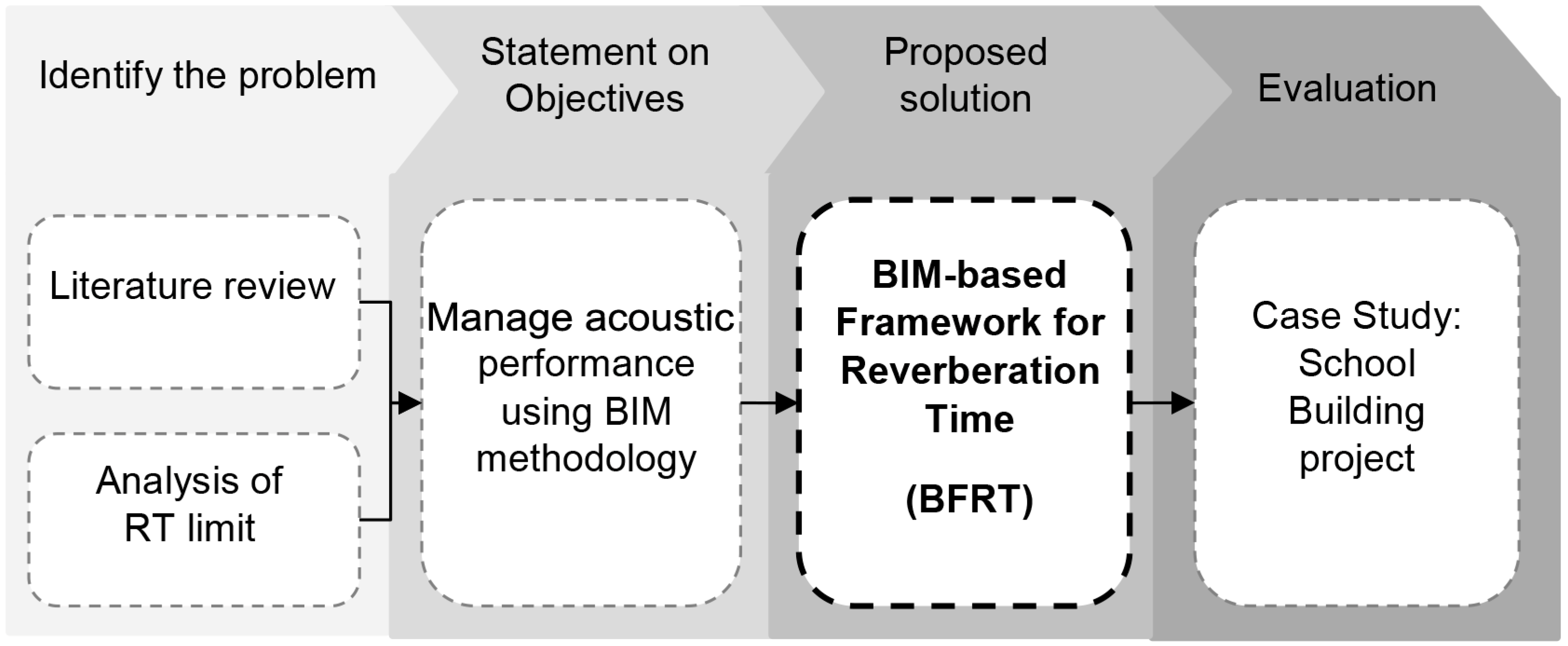
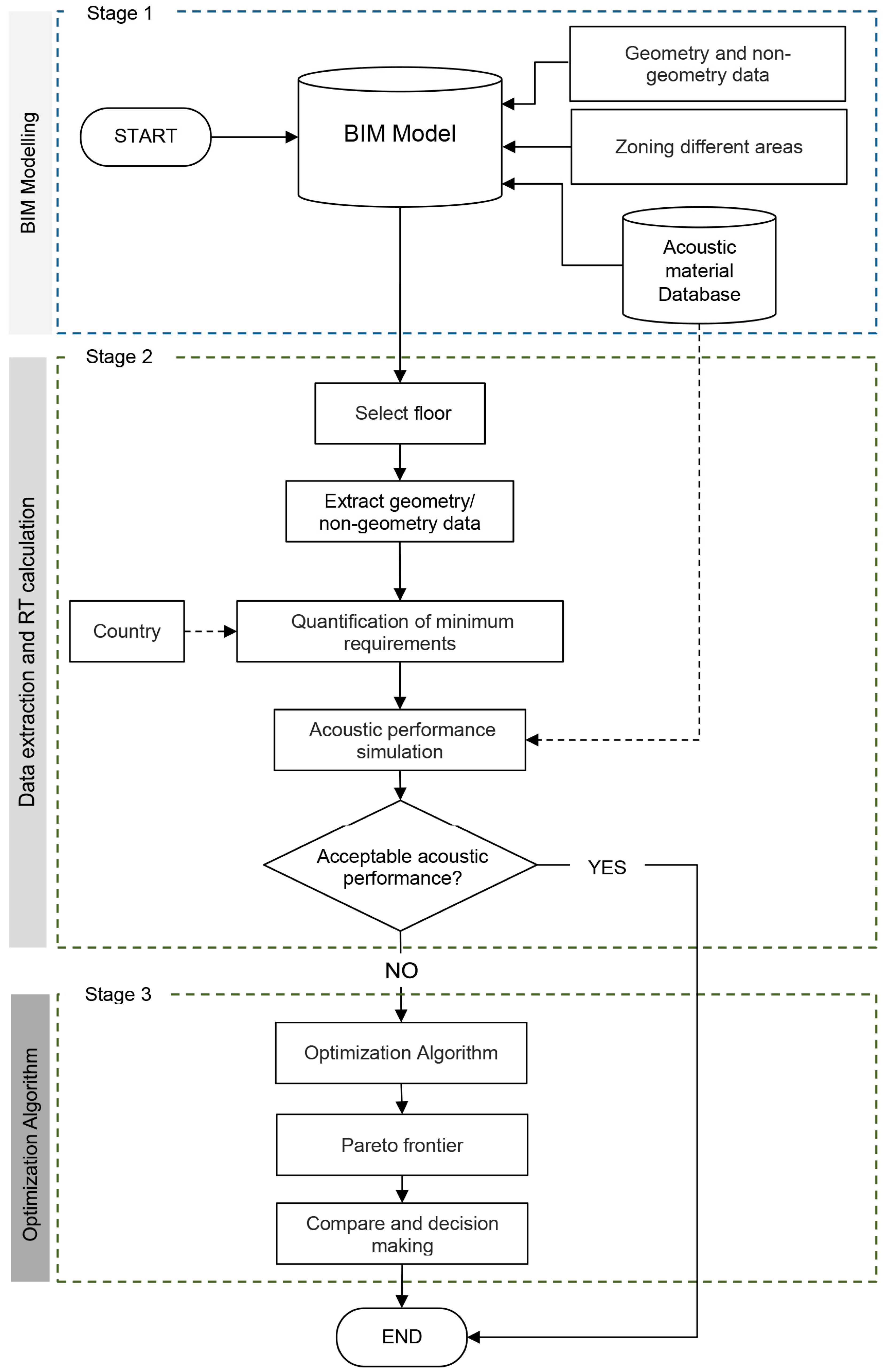
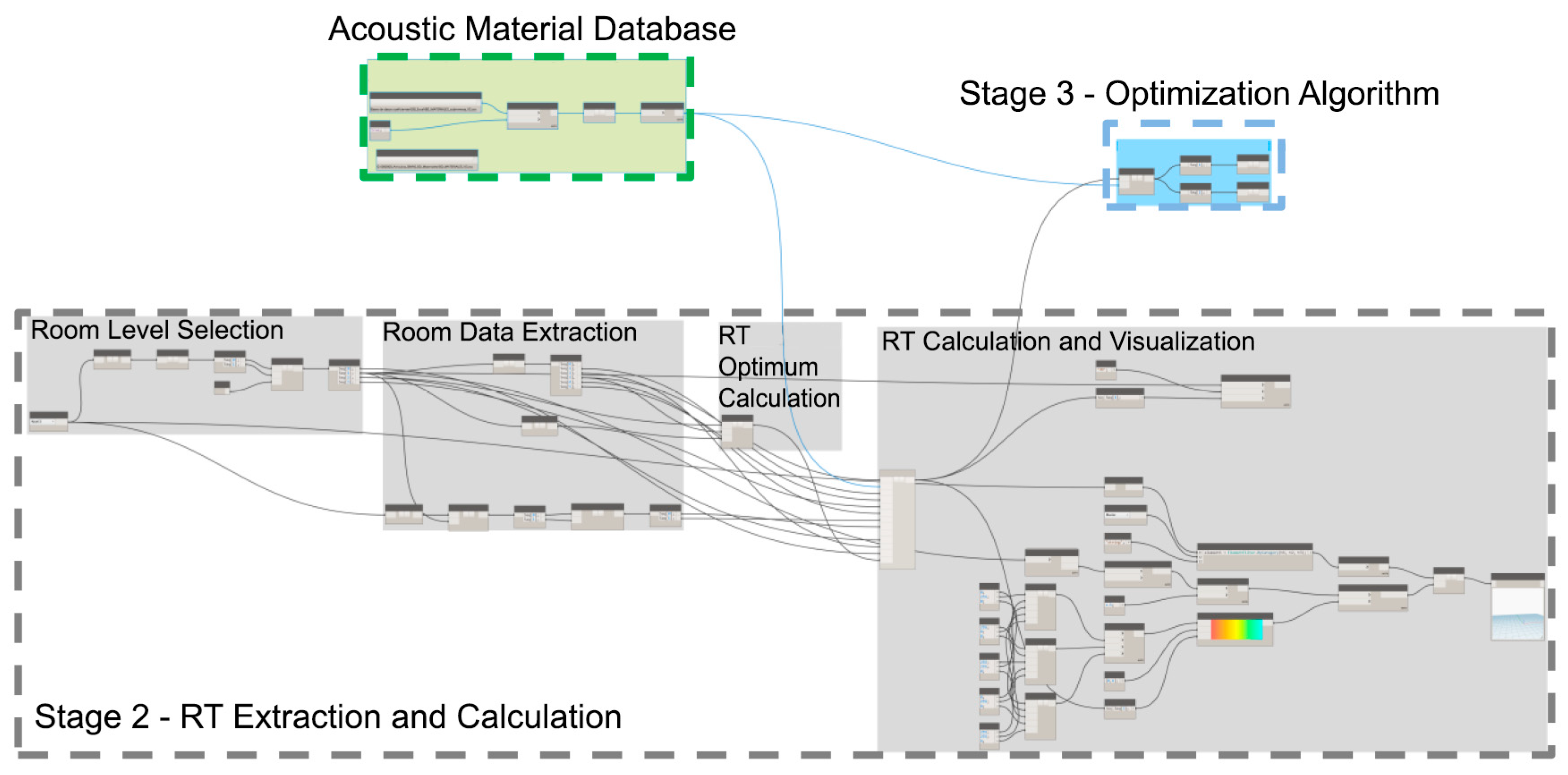
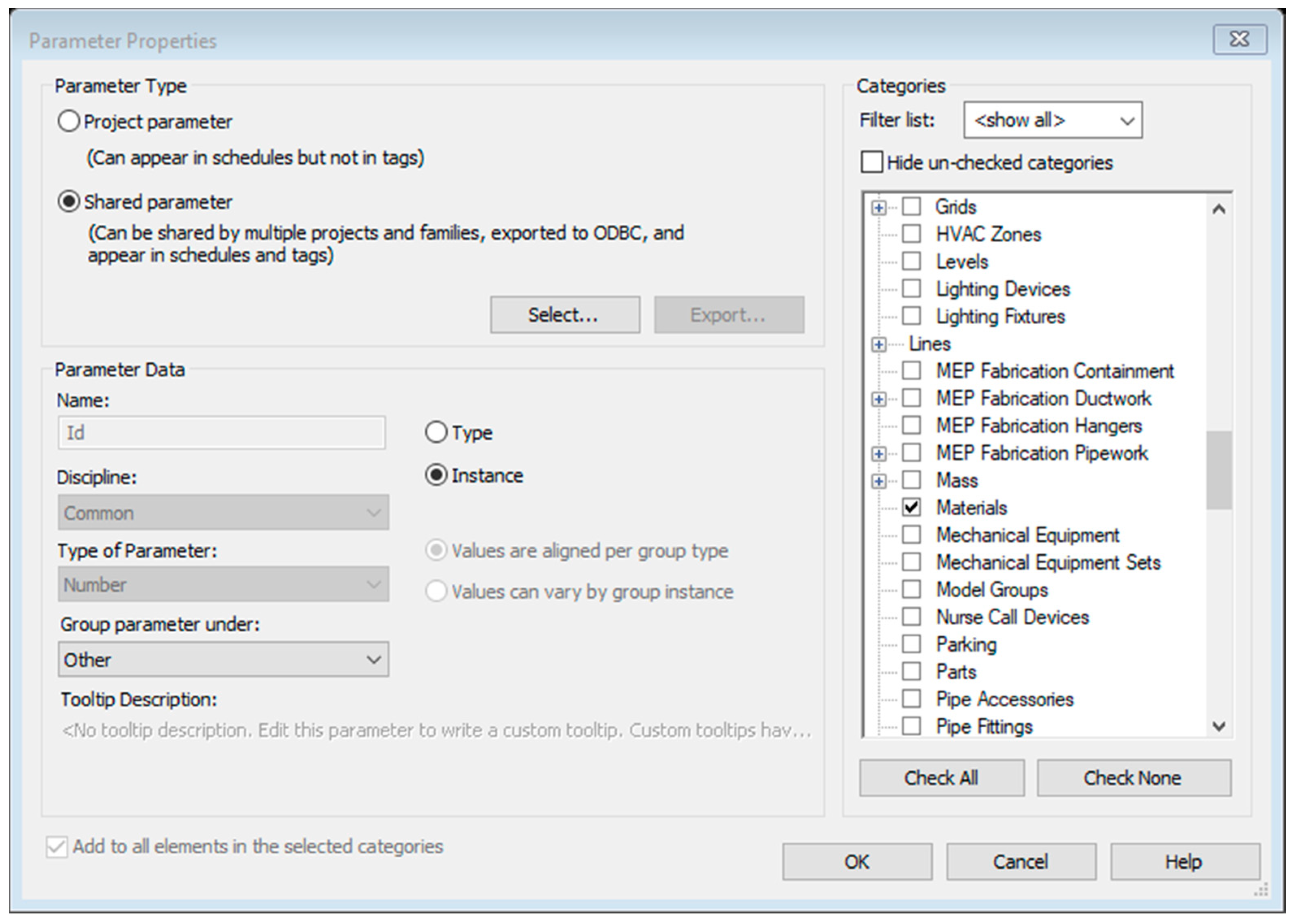
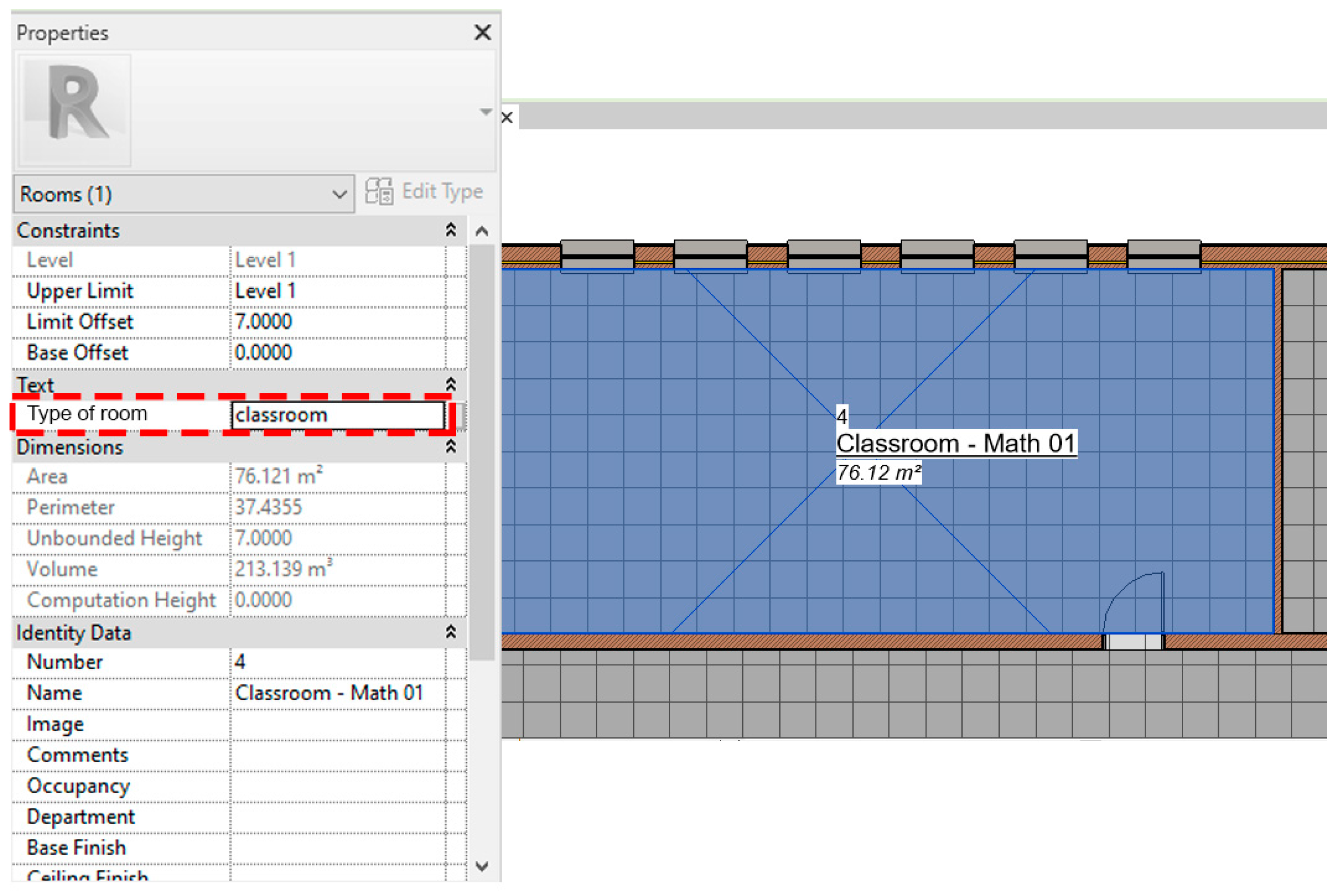
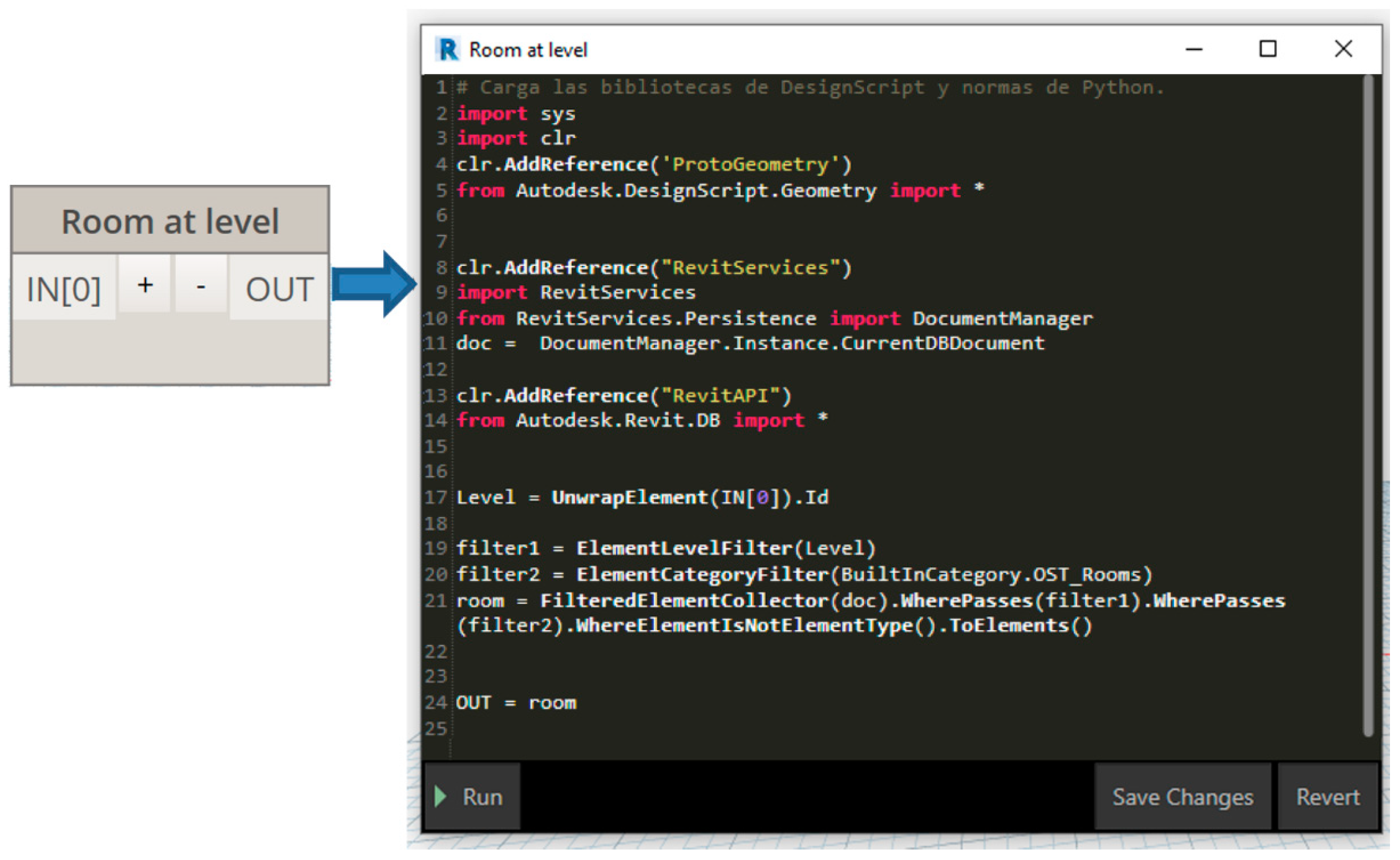



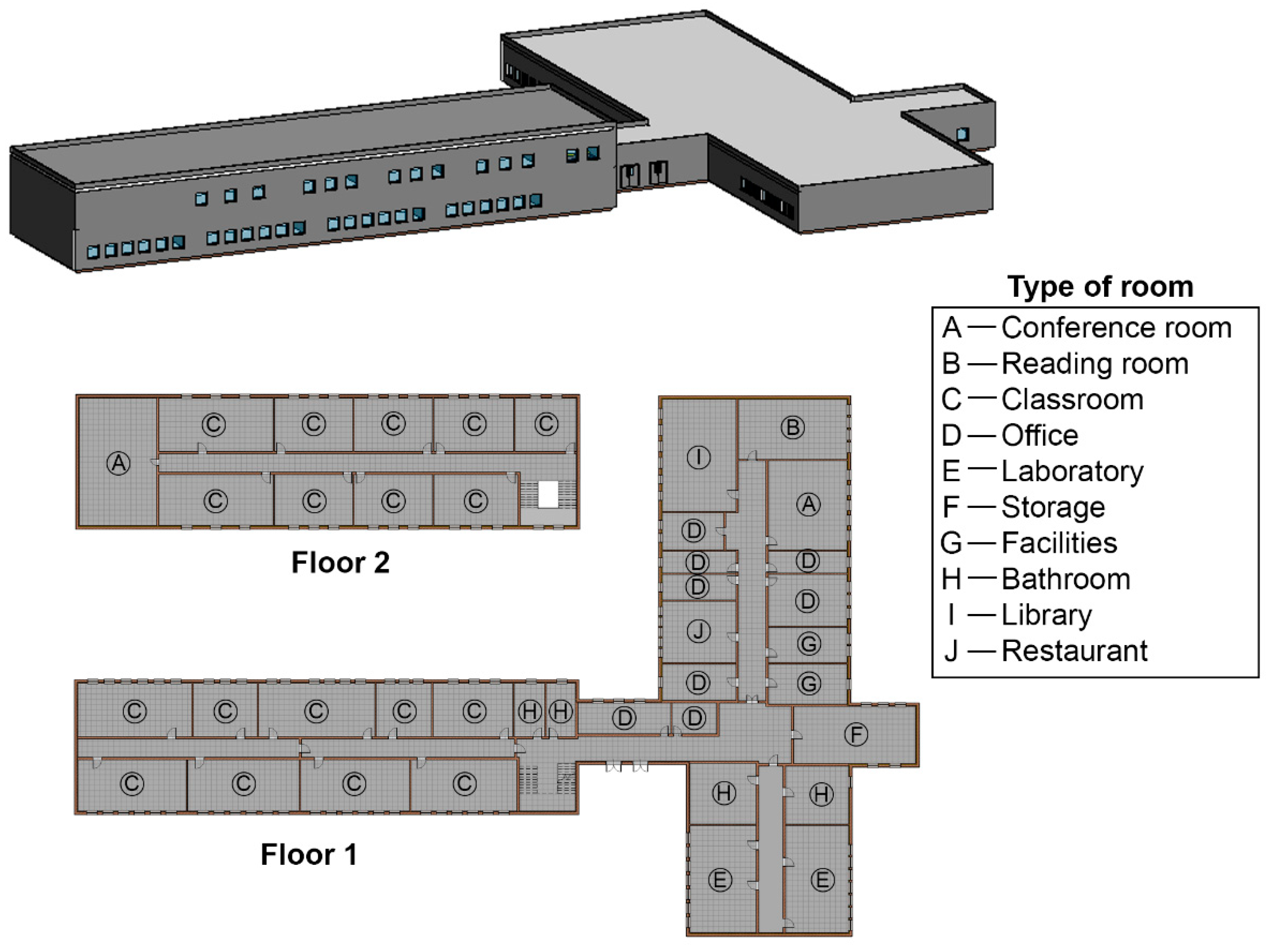



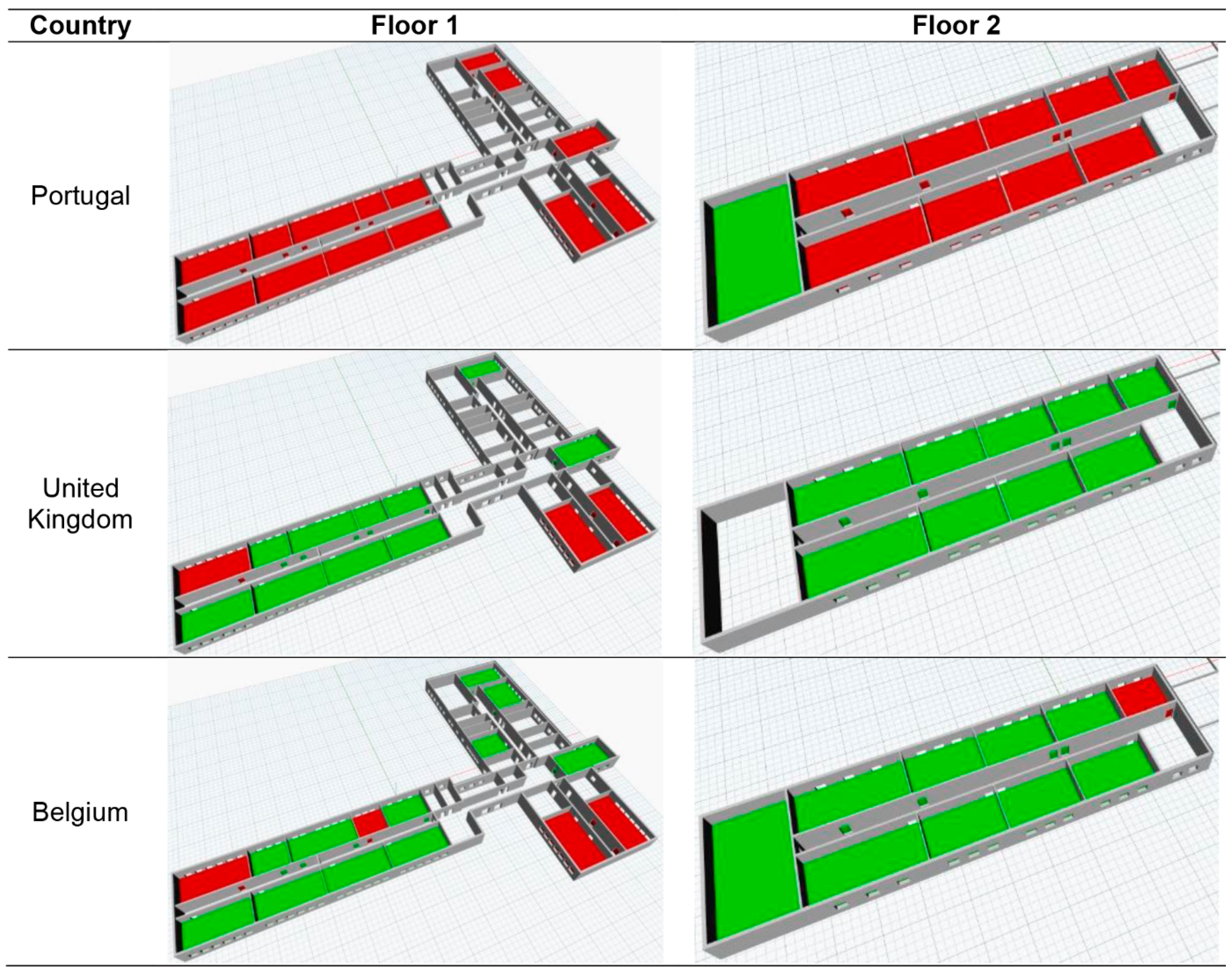
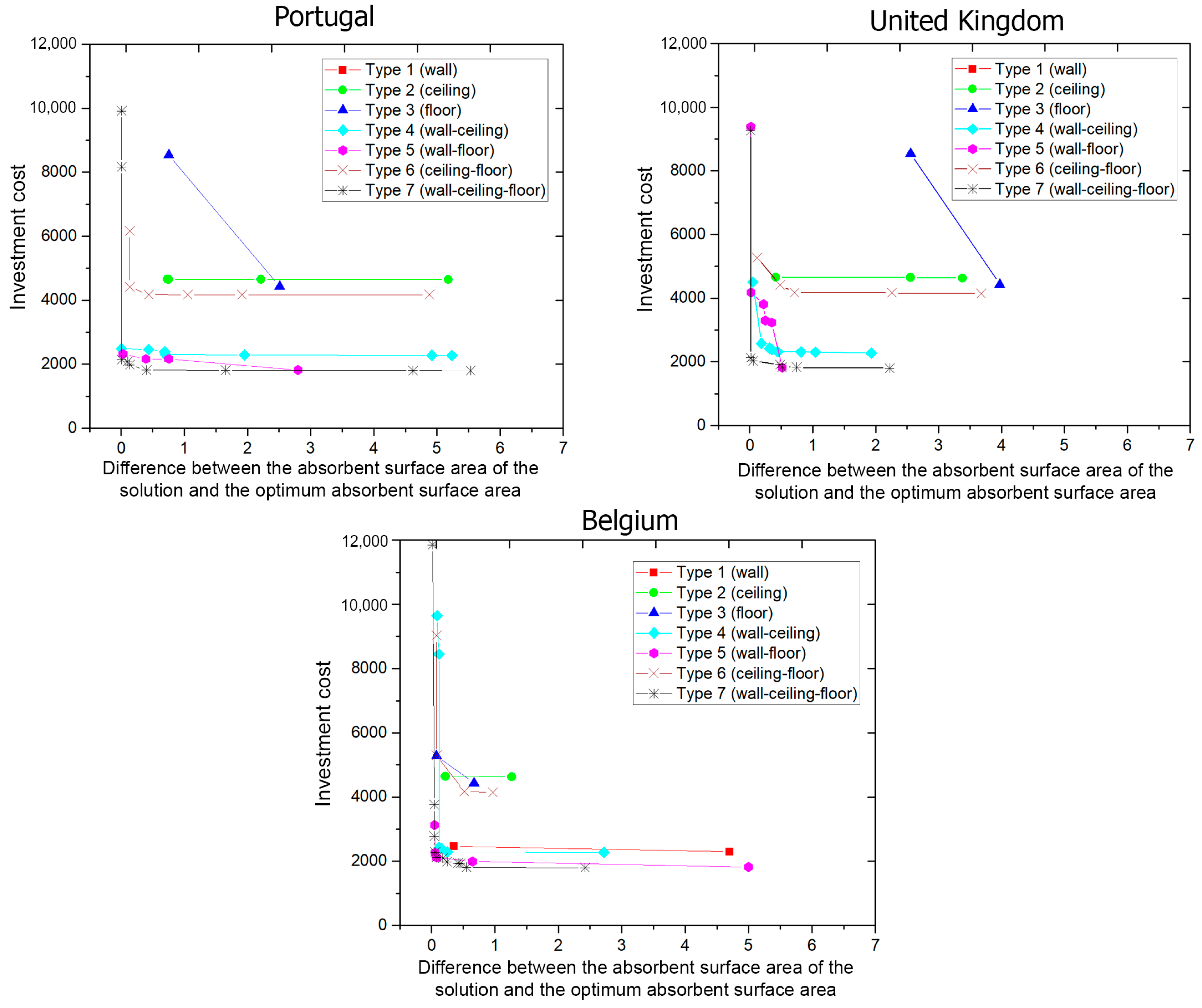
| Country | Type of Room | Requirement RT | Frequency Band | Comment |
|---|---|---|---|---|
| Spain [34] | classrooms and conference rooms | 0.7 s | 500–1000–2000 Hz | Unfurnished and unoccupied room. ≤ 350 m3 |
| classrooms and conference rooms | 0.5 s | 500–1000–2000 Hz | Furnished room. ≤ 350 m3 | |
| Restaurants and canteens rooms | 0.9 s | 500–1000–2000 Hz | Unfurnished and unoccupied room | |
| France [35] | Classrooms and polyvalent rooms | 0.4 ≤ RT < 0.8 s | 500–1000–2000 Hz | Furnished and unoccupied room. ≤ 250 m3 |
| Classrooms and polyvalent rooms | 0.6 ≤ RT < 1.2 s | 500–1000–2000 Hz | Furnished and unoccupied room. > 250 m3 | |
| Restaurant (School) | 0.4 ≤ RT < 0.8 s | 500–1000–2000 Hz | Furnished and unoccupied room. ≤ 250 m3 | |
| Restaurant (School) | 0.6 ≤ RT < 1.2 s | 500–1000–2000 Hz | Furnished and unoccupied room. > 250 m3. Special study required | |
| Sport | 0.6 s | 500–1000–2000 Hz | Furnished and unoccupied room. ≤ 250 m3 | |
| Portugal [36] | Sport | 500–1000–2000 Hz | Furnished and unoccupied room. | |
| Sport | 500–1000–2000 Hz | Furnished and unoccupied room. With Public address | ||
| Auditory, conference and polyvalent rooms | 500–1000–2000 Hz | Furnished and unoccupied room. if < 250 m3. | ||
| Auditory, conference and polyvalent rooms | 500–1000–2000 Hz | Furnished and unoccupied room. if 250 ≤ < 9000 m3. | ||
| Auditory, conference and polyvalent rooms | 500–1000–2000 Hz | Furnished and unoccupied room. ≥ 9000 m3. | ||
| Belgium [37] | classrooms and conference rooms | 500–1000–2000 Hz | Unfurnished and unoccupied room. | |
| Sport | 500–1000–2000 Hz | Unfurnished and unoccupied room. | ||
| Restaurant (School) | 1.0 s | 500–1000–2000 Hz | Unfurnished and unoccupied room. | |
| United Kingdom [38] | Clasrooms (primary school) | RT ≤ 0.6 s1 RT ≤ 0.8 s2 | 500–1000–2000 Hz | Furnished and unoccupied room. |
| Clasrooms (secondary school) | RT ≤ 0.8 s1 RT ≤ 1.0 s2 | 500–1000–2000 Hz | Furnished and unoccupied room. | |
| Lecture rooms | RT ≤ 0.8 s1 RT ≤ 1.0 s2 | 500–1000–2000 Hz | Furnished and unoccupied room. Fewer than 50 people | |
| Lecture rooms | RT ≤ 1.0 s1 RT ≤ 1.0 s2 | 500–1000–2000 Hz | Furnished and unoccupied room. More than 50 people | |
| Gymnasium/activity studio | RT ≤ 1.5 s1 RT ≤ 2.0 s2 | 500–1000–2000 Hz | Furnished and unoccupied room. |
| Shared Parameter | Definition | Type Parameter | Caegory |
|---|---|---|---|
| RT | Reverberation time of room | Number | Room |
| Type room | Type of room | String | Room |
| Id | Identification number of material with Acoustic material Database | Number | Material/Door/Window |
| Afurn | Equivalent sound absorption area of furniture | Number | Room |
| Element | Data-Type | Description |
|---|---|---|
| Name | String | Name or description of the construction material |
| Id | Number | Identification number of the acoustic material |
| α | Number | Absorption coefficient in the 125–250–500–1000–2000–4000 Hz frequency band. |
| Location | Number | Each finish material has a specific type of location (wall or/and ceiling or/and floor). |
| Cost | Number | Cost of material (€/m2) |
| Type | Replaced Material |
|---|---|
| Type 1 | Replace the wall |
| Type 2 | Replace the ceiling |
| Type 3 | Replace the floor |
| Type 4 | Replace the wall-ceiling |
| Type 5 | Replace the wall-floor |
| Type 6 | Replace the ceiling-floor |
| Type 7 | Replace the wall-ceiling-floor |
| Type of Room | Element | Finishing Material |
|---|---|---|
| Classroom/Reading room/Office/Laboratory | Wall | Plaster |
| Ceiling | 15 mm gypsum board | |
| Floor | Ceramics | |
| Storage/Facilities/Bathroom | Wall | Tile |
| Ceiling | Ceiling | |
| Floor | Terrazzo | |
| Library/Conference room | Wall | 15 mm gypsum board |
| Ceiling | Drop ceiling | |
| Floor | Parquet |
Publisher’s Note: MDPI stays neutral with regard to jurisdictional claims in published maps and institutional affiliations. |
© 2022 by the authors. Licensee MDPI, Basel, Switzerland. This article is an open access article distributed under the terms and conditions of the Creative Commons Attribution (CC BY) license (https://creativecommons.org/licenses/by/4.0/).
Share and Cite
Aguilar, A.J.; de la Hoz-Torres, M.L.; Martínez-Aires, M.D.; Ruiz, D.P. Development of a BIM-Based Framework Using Reverberation Time (BFRT) as a Tool for Assessing and Improving Building Acoustic Environment. Buildings 2022, 12, 542. https://doi.org/10.3390/buildings12050542
Aguilar AJ, de la Hoz-Torres ML, Martínez-Aires MD, Ruiz DP. Development of a BIM-Based Framework Using Reverberation Time (BFRT) as a Tool for Assessing and Improving Building Acoustic Environment. Buildings. 2022; 12(5):542. https://doi.org/10.3390/buildings12050542
Chicago/Turabian StyleAguilar, Antonio J., María L. de la Hoz-Torres, Mª Dolores Martínez-Aires, and Diego P. Ruiz. 2022. "Development of a BIM-Based Framework Using Reverberation Time (BFRT) as a Tool for Assessing and Improving Building Acoustic Environment" Buildings 12, no. 5: 542. https://doi.org/10.3390/buildings12050542
APA StyleAguilar, A. J., de la Hoz-Torres, M. L., Martínez-Aires, M. D., & Ruiz, D. P. (2022). Development of a BIM-Based Framework Using Reverberation Time (BFRT) as a Tool for Assessing and Improving Building Acoustic Environment. Buildings, 12(5), 542. https://doi.org/10.3390/buildings12050542









